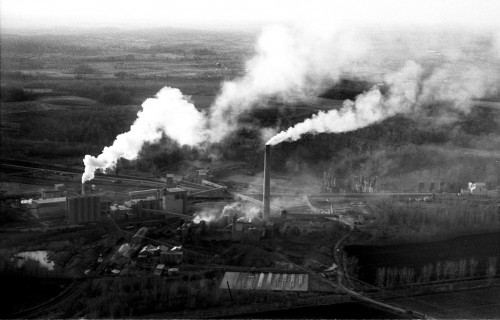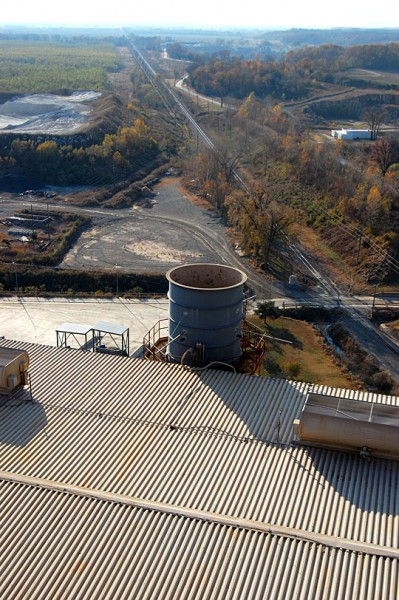 “Marquette to Cut Emission of Dust” was the headline on page one of The Missourian on March 29, 1966, about the time I shot this aerial. The quarry is to the north of the cement plant. Click on the photo to make it larger.
“Marquette to Cut Emission of Dust” was the headline on page one of The Missourian on March 29, 1966, about the time I shot this aerial. The quarry is to the north of the cement plant. Click on the photo to make it larger.
In an understatement, Charles J. Line, vice president of operations and engineering, acknowledged that the dust “is a nuisance.” He pledged the company’s best efforts to alleviate the problem.
Dust from the cement plant coated cars, wash on the line, even the streets with a gritty white powder. Mr. Line said that to totally eliminate the dust would be virtually impossible; the reduction to half is about the best result which reasonably can be expected, he added.
Technology, regulations cleaned up the air
 Looks like tighter regulations on pollution and better technology accomplished more than Mr. Line ever thought possible. Here is a photo I took Nov. 10, 2010 from the ninth floor of the Buzzi Unicem USA cement plant. The round object in the center is the equivalent of the dust-belching stack in the aerial photo from the 60s. The only thing I could detect coming out of the stack was heat, as evidenced by a slight distortion in the photo. The white building at the right of the frame is the Natatorium. The view is to the west.
Looks like tighter regulations on pollution and better technology accomplished more than Mr. Line ever thought possible. Here is a photo I took Nov. 10, 2010 from the ninth floor of the Buzzi Unicem USA cement plant. The round object in the center is the equivalent of the dust-belching stack in the aerial photo from the 60s. The only thing I could detect coming out of the stack was heat, as evidenced by a slight distortion in the photo. The white building at the right of the frame is the Natatorium. The view is to the west.

When Dad was Plant Manager, his number one concern always seem to be the dust collection when dealing with the public. CJ Line was Dad’s boss from Chicago. I don’t remember if these were the first dust precipitators Marquette installed, but they were a maintenance nightmare.
Cement dust caused some interesting situations. I think I may have mentioned this before in a previous comment but almost all employees rented a garage from the company or had an old car. I don’t remember much about the garages as I believe they were done away with in the 70s.
In the 1950s, most employees had an old car they drove to the plant. I remember a trade Dad made of his 1925 Ford coupe for a 1914 Hudson sedan and $15.00. Mom would load up us kids in that Hudson and drive all over town. We called it our hoop-t-mobile. There was a road over some hills behind the Natatorium that wasn’t used on the weekend so we would go over the road, up and down in the hoop-T-mobile with all of us bouncing around.
Later in the late 1950s andearly 1960s, Dad used a 1951 Chevrolet, my first car when I started driving, which I shared and named “The Gray Ghost”. It had come with us when Dad was transferred back from Milwaukee so I never could stop it from rusting.
Even after the collectors were installed I remember well that thin coating of dust you could see on your car. Sorry about that, but thanks, Ken, for the memories.
It’s pretty impressive how well pollution controls work when you look at the before and after photos.
The current plant manager was amazed when he saw the old photos.
I forgot to mention that the cement dust could really be bad in Cape if the wind was blowing north. I am sure Scott City would capture the dust if the wind blew south. As you stated the collectors helped then but didn’t eliminate the dust. I wonder if it is still a problem.
My dad worked in the plant for 30 years as time keeper. He always drove an old Ford to work. He was not lucky enough to have a garage. I would try to wash the car for him, but it was like washing concrete. I learned to drive on his old dusty Ford, though.
My dad’s ’49 Chevy ended up being a chalky red color by the time he bought a new car in 1961 due to the cement dust. Add a little dew to the dust and it would do a fantastic job of etching the paint.
My dad took photos in 1963 from the top of the 16-silo mass. You could see the dust build-up on top of the buildings and vent louvers.
When I was a kid, I remember having to wipe the clothes lines with a cloth to remove the cement dust before hanging laundry. Hadn’t thought about that in a long time.
Oh Lila, that’s amazing. I remember doing the same thing but like you, hadn’t thought about it in forever. I do remember our car always having a dusting of “dust”. We lived in South Cape so we were pretty close to the source.Thanks for reminding me!
Looking at the picture from 2010 again, my eye was drawn to the railroad tracks(naturally), and I wondered how many people were aware that those old Cape Girardeau & Southwestern/Frisco tracks use to continue in that straight-line southwestern tack, with virtually no curves, all the way to just east of Puxico; over 40 miles.
I worked at Marquette a little over a year – 1956/1957, as a “swing-man” on 5 different jobs, and one of them was in the mill, grinding the rock mix and it was a killer job with all the dust. One guy that worked in the mill for 15 years had lungs caked with cement dust and would spit up blood from it. His nick-name was “Arky”! I had taken the test for the Post Office before I went to work at the plant and as soon as they called me , I weighed the differnt working conditions on health, and took a pay-cut to go to the Post Office as a clerk/carrier substitute, ending up as a letter carrier, and I don’t believe I would have made it to almost 84 if I had stayed at the cement plant. I rode an old Harley cycle to the plant and was able to park it where the dust wasn’t to bad. I was raised on south Benton- 1200 block, so I sure know about the dust on the cars issue. My move to Florida with the post office in 1961 sure got us awat from the dust problem!
Joe Whitright “45”